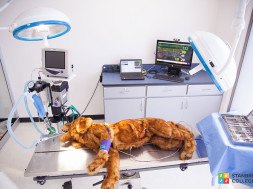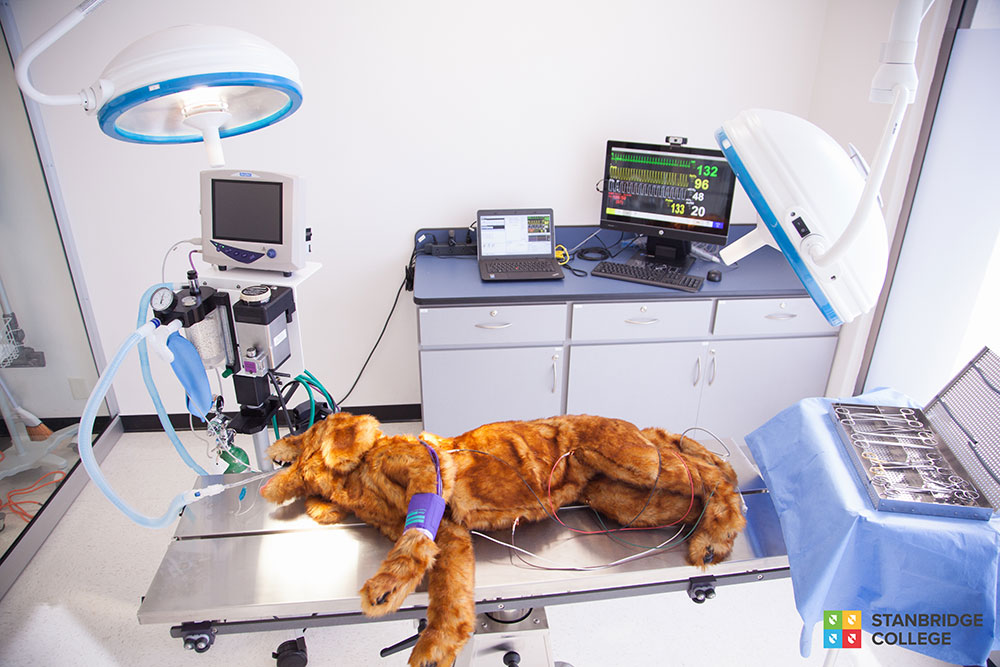
Robo-Dog: Stanbridge College Introduces Cutting-Edge Technology for Veterinary Students
Written from an interview with Yasith Weerasuriya, President and CEO, Stanbridge College
Stanbridge College is an example of the introduction of new technology in a manner that directly improves the quality of their students’ education, by providing “hands-on” clinical experience that will prove valuable for their future careers.
Stanbridge’s newest educational innovation is the introduction of a high-fidelity canine patient simulator for veterinary technician training — the only one in the U.S. outside of Cornell University College of Veterinary Medicine, where it was first developed by Dr. Daniel Fletcher, Associate Professor of Emergency and Critical Care at Cornell University School of Veterinary Medicine. The canine manikin is sometimes referred to as “robo-dog” or “Robo-Balti” affectionately named after the college’s first mascot, Balti, a Yorkshire Terrier.
Founded in 1996, Stanbridge, based in Irvine, California, has an annual enrollment of approximately 1,200 students and offers specialized degree programs leading to master’s, bachelor’s, and associate’s degrees, as well as diploma programs in healthcare. Stanbridge is nationally accredited by the Accrediting Commission of Career Schools and Colleges (ACCSC) and holds additional accreditations from CCNE, BVNPT, ACOTE and CAPTE.
Yasith Weerasuriya, co-founder, President, and CEO of Stanbridge College, and his team have transformed a school initially focused on Information Technology into a multi-disciplinary college on the cutting-edge of healthcare training in just over nine years.
DOWNLOAD ARTICLE“We started off as an Information Technology college,” Weerasuriya said. “That was in 1996, the dawn of the Internet as we know it today. Over time, we morphed from an institution that provided training in Information Technology to a nationally accredited institution offering programs in Nursing, Physical Therapy, Occupational Therapy, and Veterinary Science.
Stanbridge added a Veterinary Technology program in February 2014. “Our program is new,” Weerasuriya said. “We found a lack in veterinary technician training in Orange County and wanted to fill the need for competent, skilled workers. The program is in the process of completing its AVMA accreditation, in line with all the other programs that have programmatic accreditation.
“In veterinary technology training we do similar clinical training to our human health programs,” Weerasuriya said, “we have clinics and surgical suites on campus that are approved by the state. In the first year, students perform dental cleanings, vaccinations, flea treatment, deworming, microchipping, ear cleanings, nail trimming, and diagnostics such as blood work and X-rays on live animals. We train our students to do these procedures with supervision from our professional faculty on-site.”
“As students advance to the second year, we teach surgical procedures on campus,” Weerasuriya continued. “We have fully licensed veterinarians and veterinary technicians on staff with a veterinary clinic and separate surgical suite that has all the latest equipment.”
With a record for award-winning community service engagement, Weerasuriya described Stanbridge’s approach to clinical education as one that includes service to the community: students learn to spay and neuter rescue animals that would otherwise have a challenging time getting adopted. “Our veterinarians and staff do the surgery with our students assisting and learning,” he explained.
“Without vaccination, microchipping, and spay and neuter surgeries, they would not be attractive candidates for adoption.” As Weerasuriya sees it, the school’s service is a win/win – for the school, the veterinary tech students, and the community.
Stanbridge’s introduction of a high-fidelity canine patient simulator for veterinary technician training — the only one in the U.S. outside of Cornell University College of Veterinary Medicine, where it was first developed by Dr. Daniel Fletcher, was an easy decision. Weerasuriya pointed out that Stanbridge has established experience using simulation training in the human sciences. “We have a very strong simulation program that is used by our Nursing, Occupational Therapy, and Physical Therapy degree programs,” he said, “and we are beginning to introduce acute simulation scenarios in our dialysis program.”
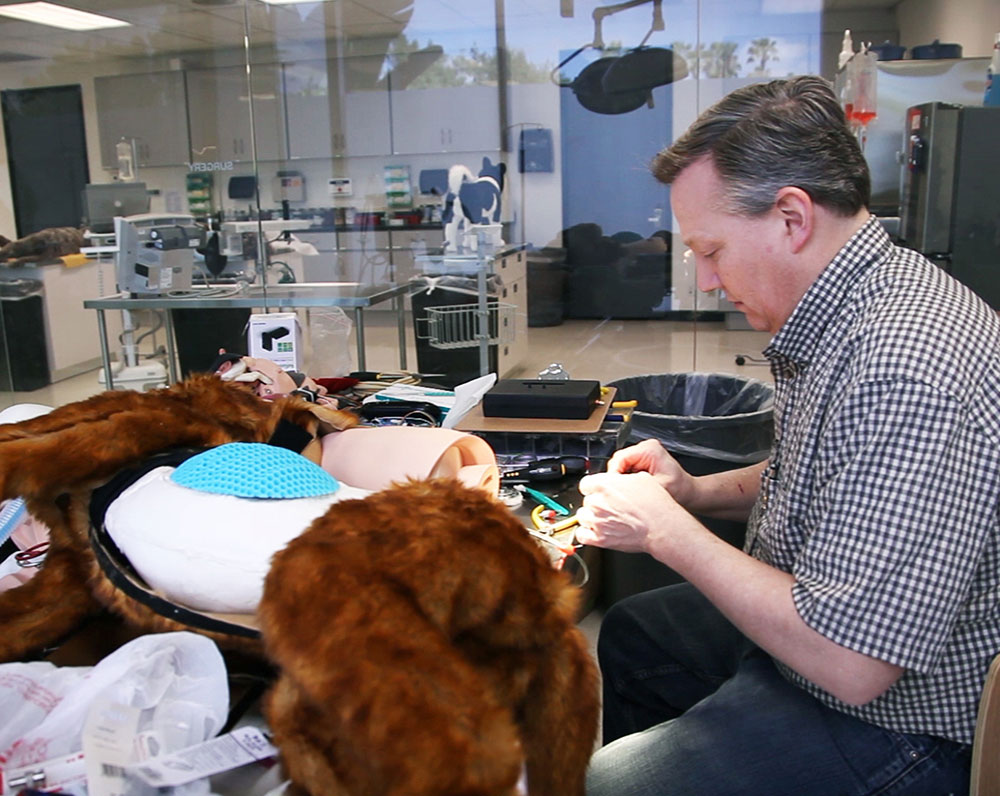
Since the school had experience in clinical simulations, when Weerasuriya came across an article about clinical simulations for veterinary medicine, he followed up immediately.
The clinical simulation device was the work of Dr. Daniel Fletcher. Dr. Fletcher received his Ph.D. in bioengineering and subsequently decided that he wanted to become a veterinarian. He later went on to become a member of the faculty at Cornell University.
Weerasuriya described his first encounter with Dr. Fletcher, recalling “Dr. Fletcher was traveling around the world explaining how simulation works in the veterinary world, with presentations in Japan, the United Kingdom, and the U.S. We invited him to visit and demonstrate the technology to our students, faculty and to our advisory board.” After seeing the impact of the canine simulator Stanbridge was ready to take the next step.
“We had a very open discussion,” Weerasuriya said. “We said that we would like to see about building such a simulator here at Stanbridge,” Weerasuriya said.
Dr. Fletcher was able to see that we have a very well-established human simulation program and he felt comfortable expending his energies to build a unit here at Stanbridge.
The canine simulator had a significant impact; Weerasuriya said: “We were just thrilled when we saw students able to develop their skills in a safe, clinical environment. They were able to deal with an acute scenario on a canine patient over and over again until they had mastered the skills they needed to move forward. Something seemingly as simple as chest compressions for CPR proved to be one of the biggest learning points for our students. Previously, the students would think they were in danger of breaking the ribs of their patient during CPR, but received feedback from the simulated manikin that they were actually not compressing hard enough. Students would never be able to get that feedback from a live animal because live animals do not have the diagnostic capabilities of the computers in the simulator.”
Another significant benefit of the simulator is that it creates a team environment and promotes collaboration in the surgery room. “With the simulator, we are not only dealing with one student, but creating scenarios that build the team that would intervene in an acute scenario,” he noted. “With a veterinary patient, we could see the students in minutes begin to gain confidence, develop leadership skills and above all, be able to deploy what they have learned in a real environment without having real patients.”
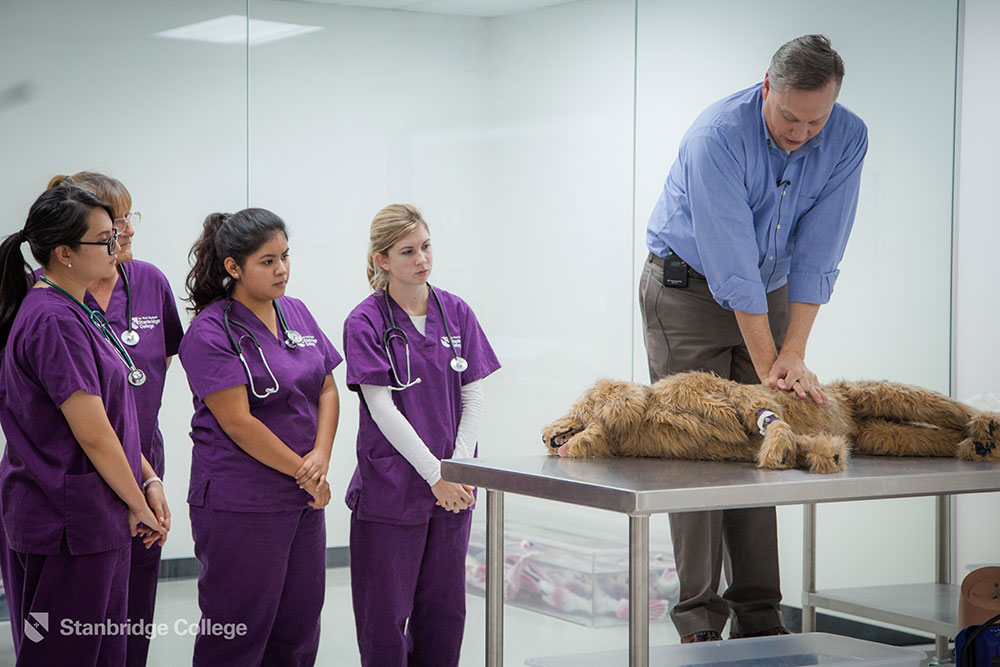
While Weerasuriya was delighted to house the unit permanently as a training tool for students, as CEO he was also aware that the canine simulator would require substantial investment.
“It is an expensive project,” Weerasuriya said. “There are only two instances of this canine simulation available in the world: this one, and the initial version created by Dr. Fletcher that resides at Cornell University.”
Despite the investment costs, Weerasuriya is committed to introducing cutting-edge technology at his college and using it to expand the appeal of his school to veterinary and healthcare students.
“We have typically invested in what we believe to be necessary components to create outstanding graduates,” he said. “Over its eight-year period of existence, our Nursing program has maintained a 91 percent multi-year average pass rate with one of the top three volumes in the state. In our Occupational Therapy Assistant program, we have a 96 percent and in our Hemodialysis Technician program a 95 percent multi-year average annual pass rate. We typically look for the holistic graduate not only to be able to pass the licensure exams, but also to acquire clinical skills. It is very obvious to us that the investment we would be making in simulation capabilities for veterinary technology would simply produce a much more confident graduate.”
For schools that are considering adding veterinary technology – even without cutting-edge canine simulator technology – Weerasuriya says the college has significant challenges in costs, in part due to regulations.
The costs of equipping a veterinary lab and surgery suite are also significant. “In the veterinary world, because you do a considerable amount of vet training, you need to have digital X-ray machines as well as analog X-ray machines,” Weerasuriya explained. “Those rooms need to have lead-lined walls. Frankly, the investment and the equipment and technology in the veterinary world is definitely more than what we would need to invest in some of the human health labs because you are dealing with the redundancies.
“For example, if we are dealing with the surgical suite, you need to have two different anesthesia machines – one as your primary and one as a backup. You are dealing with the light source. You are looking at generators for power. You cannot be in the middle of an operation and run out of power. In regards to accreditation, all of those little details are where the work lies.”
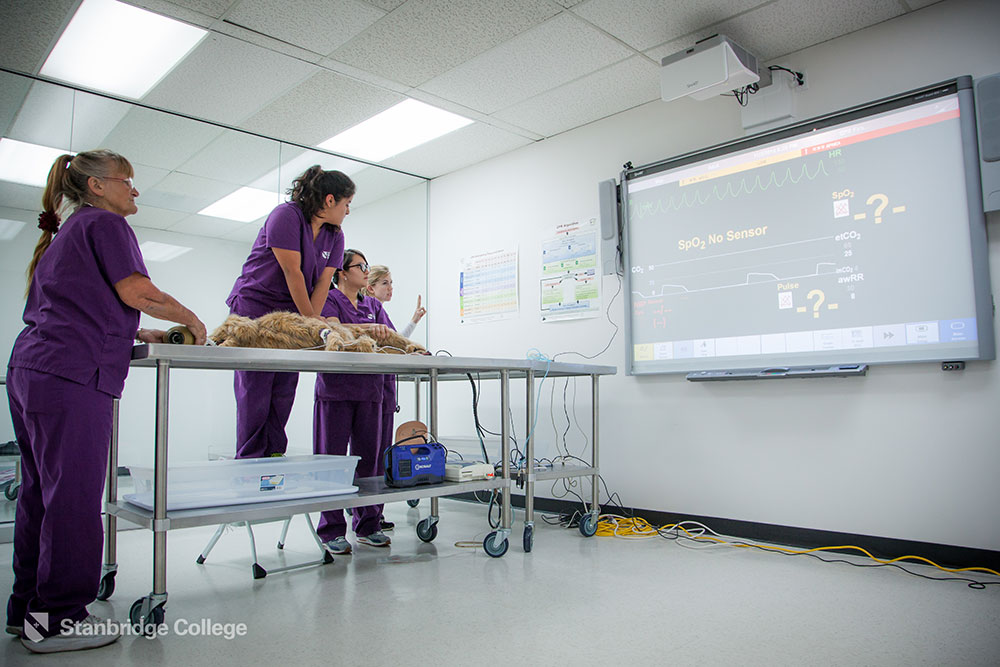
Weerasuriya said the veterinary medicine and technology courses are rigorous, with students taking both classroom and clinical education prior to surgery training. “There is a very, very strong science component to the program with foundations in anatomy, physiology, biology, chemistry, and mathematics,” he said. “Those are areas we look at very carefully from the admissions criteria because typically the students who come into this [veterinary technology] program tend to be young. The students really enjoy working with animals and everybody wants to cuddle kittens and puppies, but they are not quite as comfortable going through the Anatomy-Physiology course and dissecting the animals and looking at intubations and other critical and delicate procedures on patients. We make sure we get the right candidates so that they, as graduates, and our program are successful.”
Weerasuriya is optimistic about the benefits of “Robo-Balti” as a teaching tool. “The difference between somebody who has on-the-job training and someone who has gone through the veterinary technology licensure training, is that this [licensed] person has an additional depth in anatomy, physiology, biology, chemistry, anesthesia and analgesia.”
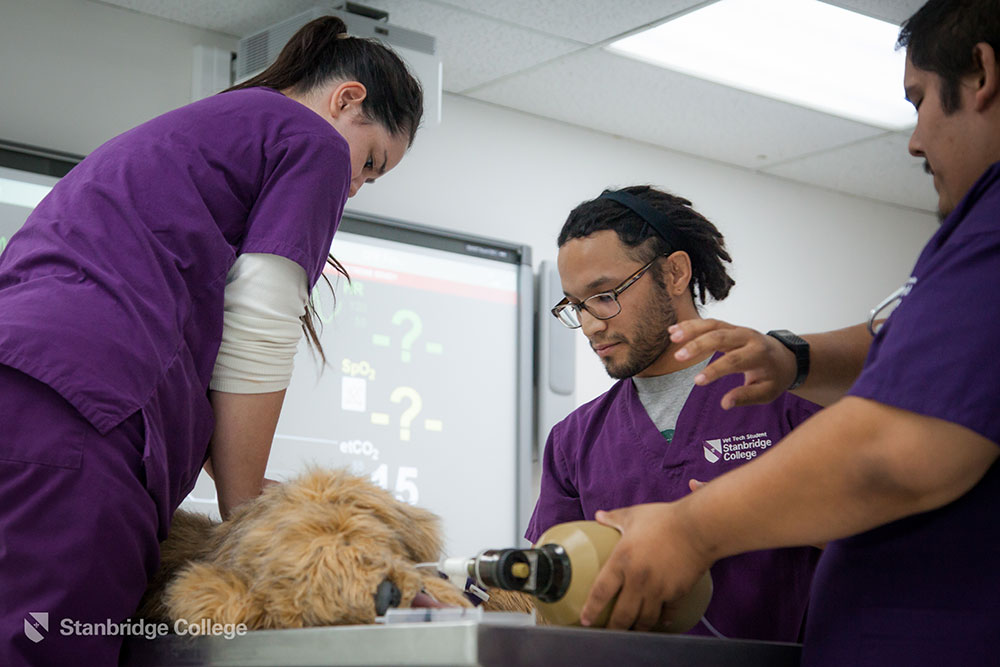
YASITH WEERASURIYA Ccurrently serves as President of Stanbridge College. With over 18 years of executive leadership experience in the education sector, Mr. Weerasuriya’s range of expertise in education spans from specializations in the Information Security and Fiber Optic Technology fields to Business, Allied Health and Nursing.
After working with the Special Projects Department at Irvine Valley College in 1996 to implement a partnership between Microsoft and 107 California Community Colleges to start training programs for the newly introduced Windows 95 Microsoft desktop and NT network platforms, Mr. Weerasuriya founded Executive 2000 Inc., which is today Stanbridge College. Executive 2000 quickly grew to become an industry leader in Information Technology, Information Security and Optical Fiber Training in California. In 2003 Mr. Weerasuriya led the organization to national accreditation and broadened the focus to include medical and business training. Subsequently, he led the college to receive its charter to grant Associate’s, Bachelor’s, and Master’s degrees in Information Technology, Occupational Therapy, Physical Therapy, Nursing and Veterinary Science.
Mr. Weerasuriya has a wide range of interests. He enjoys drawing with a special focus on African tribal face drawings. He enjoys spending time on the weekend boating and is an ardent student of world affairs. Mr. Weerasuriya is an active member of the World Affairs Council of Orange County where he is a Trustee and recently served as Chairman. He is also on the Board of Directors of the Orange County Workforce Investment Board, the Second Harvest Food Bank, and the California Association of Private Postsecondary Schools.
While at Wichita State University and Irvine Valley College, Mr. Weerasuriya was founding President of the College Chapter of Phi Theta Kappa, President of the Alpha Gamma Sigma chapter, President of the Honor Society and President of the Martial Arts Club where he studied Aikido, Iaido and Eskrima Arnis. While in High School, he was Student Body President, Red-Cross Club President, Hospital Volunteer Club President and Editor of the School Magazine as well as a Debate/Forensic representative.
With a Sri Lankan heritage and having lived for twelve years in Kenya, Mr. Weerasuriya speaks Swahili and Sinhalese in addition to English. Mr. Weerasuriya is married to Lu Ann Hancock Weerasuriya, daughter of former U.S. Congressman Mel Hancock of Missouri. They recently had boy/girl twins and reside in Orange County, California.
SIDEBAR
Stanbridge College The Stanbridge campus in Irvine, California includes classrooms, computer labs and laboratory facilities for Nursing, Hemodialysis, Veterinary Technology, Occupational Therapy and Occupational Therapy Assistant, and Physical Therapy Assistant degree programs.
Stanbridge College has been recognized for its excellence in several areas:
- 2013 – Accrediting Commission of Career Schools and Colleges (ACCSC) Community Service Award Winner for outstanding outreach to its local and global community
- 2009-14 – Named to the President’s Higher Education Community Service Honor Roll, the highest federal recognition a college or university can receive for its commitment to volunteering, service-learning, and civic engagement
- 2009-14 – Awarded one of America’s Best Technical Colleges, years 2009-14, by Institutional Research & Evaluation, Inc.
- 2013 -14 – OTA graduates achieved a 96 percent average annual NBCOT-COTA exam pass rate
- 2007-2014 – Vocational Nursing graduates have achieved a 91 percent average annual NCLEX-PN pass rate
- 2013-2014 – Hemodialysis Technician students achieved a 95 percent average annual CDC CHT exam pass rate
